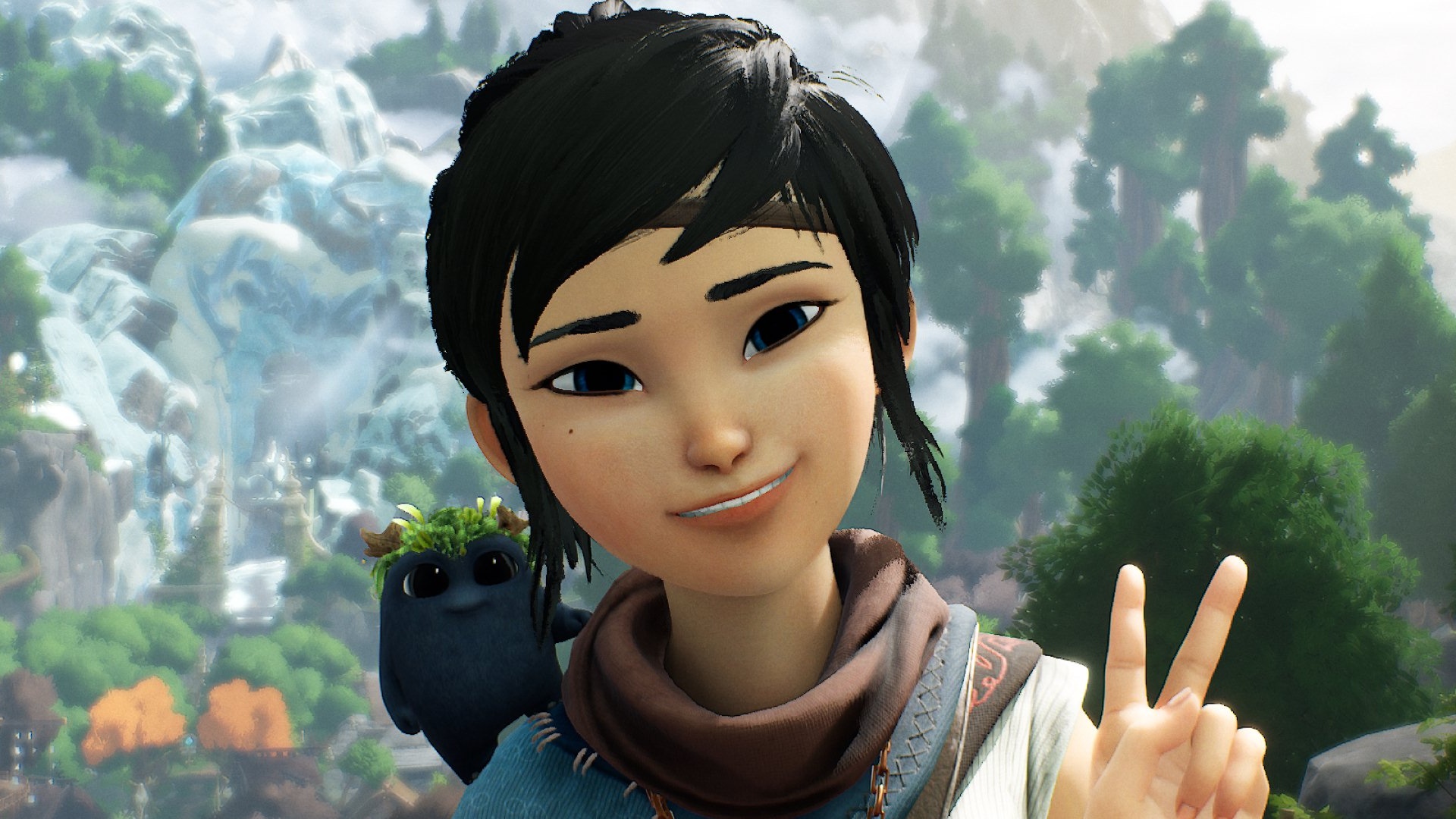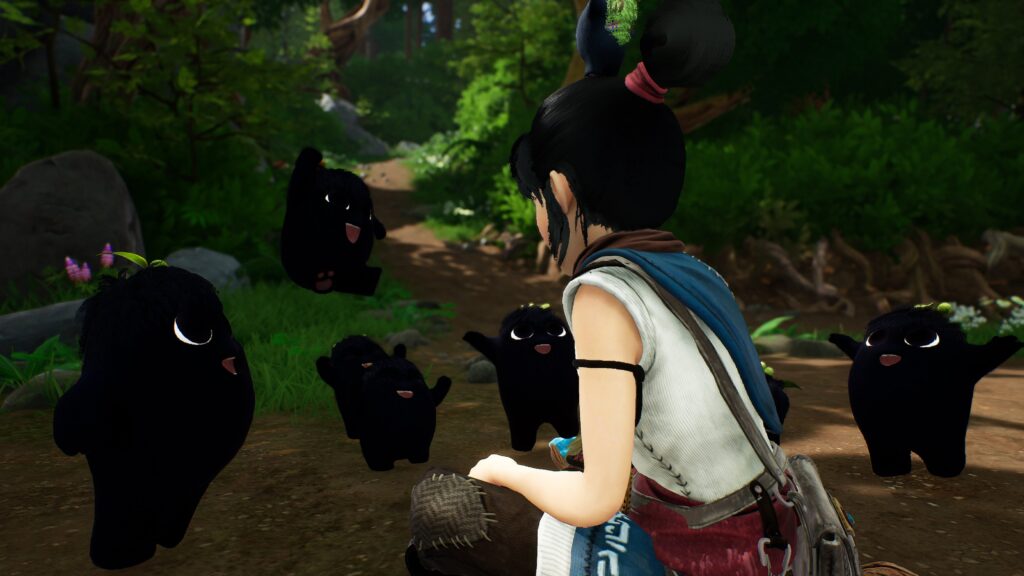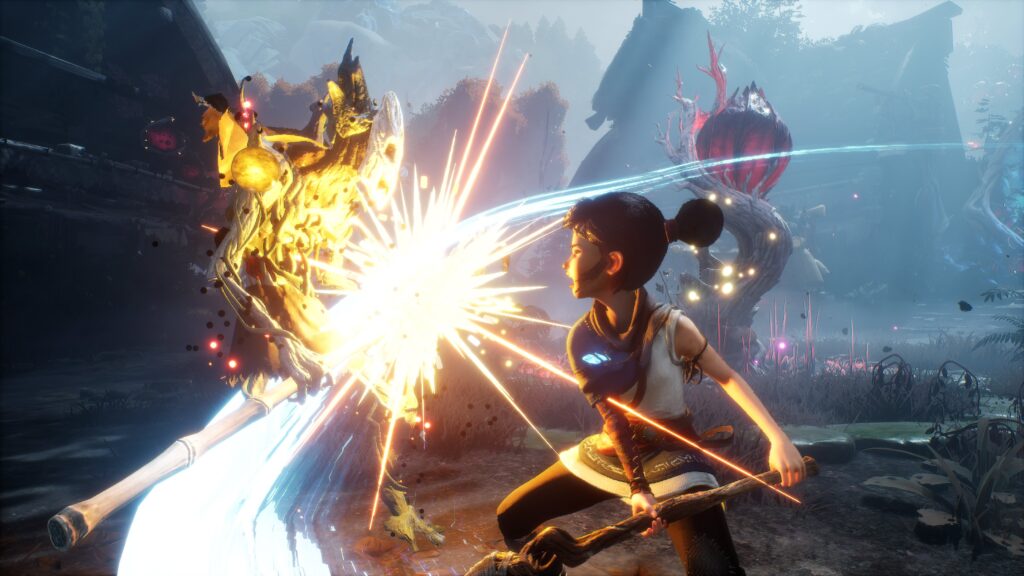Title – Kena: Bridge of Spirits
Platforms – PS5, PS4, and PC
Release Date – September 21st, 2021
Developer – Ember Lab
Publisher – Ember Lab
MSRP – $39.99
ESRB – T for Teen
Disclaimer – This product is being reviewed on the PlayStation 5. A review copy was provided by the Gaming Instincts Staff for the purpose of this review. This review may also contain spoilers for certain gameplay and story elements. Watch at your own risk, you have been warned. Gaming Instincts is an Amazon Affiliate and does gain financial benefits if you choose to purchase this product on this page.
As with the adorable, innocent-looking Rots that trot behind you in combat, Kena: Bridge of Spirits is deceptive. Ember Labs, formerly an animation studio, wrapped Kena with an innocent, kid-friendly appearance hiding a difficult combat system akin to the time-sensitive parry system of Dark Souls. Additionally, the beautiful scenery screams PlayStation 5 while the precise platforming screams PlayStation 2.
Out of all the deceiving ideas that Kena: Bridge of Spirits brings forth, the simple fact that it’s a good game is the most shocking and rewarding of them all. An animation studio with no previous development experience pulled off a game that Sony can happily add to their list of exclusives despite some shortcomings along the way.
The Lonely Life of a Spirit Guide (Story)
Kena drops into a dark, damp cave and follows the blue lights brightening the path ahead. In no time at all, we discover that she is a spirit guide, a title passed down by her father. Her job is an important one: to help spirits overcome a tragedy of their past and peacefully pass into the spirit world. The spirits don wooden masks in this passing period, which evaporate into beautiful particles after they successfully cross over.
On a quest to remediate a handful of corrupt spirits, Kena embarks on a journey through the aforementioned cave and enters an island ravaged by a mysterious tragedy. The story then follows Kena as she helps a series of spirits and uncovers the truth behind their corruption. The story at hand has a foundation to be something special but suffers from a sense of brevity and an insistence to stay surface level. Kena, for instance, had the chance to be a fascinating character based on the idea of loneliness that spirit guides must endure. As part of the job description, a spirit guide must befriend spirits only to see them pass on.
The situation should have been a deeply emotional struggle for Kena, but she never goes further than a brief mention that she misses one of the passing spirits. In addition, we don’t learn much about Kena until late in the game, and even then, it wasn’t much. There are moments where Kena speaks wisdom into disheartened spirits, but it doesn’t feel earned. We don’t know who this person is and where this wisdom is coming from. The spirits, on the other hand, are much more likable because they give us something to grasp onto.
We watch the deep love Taro has for his little brothers Beni and Saiya and understand their desperate need for reconciliation. Each spirit Kena helps is affected by the island’s cataclysmic event and we see how it separates them from those they love. The journey of each of these side characters is deeper and much more effective than the overarching story being told. Speaking of which, due to the crowded final act, the plot develops suddenly and unexpectedly in a way that should have happened throughout the game.
The antagonist suffers the most from this since his story is crammed into the last 30 minutes or so. There is no time to explore his motives and personality making sudden character changes jarring and nonsensical. The same sense of brevity can be said about the main crux of the story – the cause of the cataclysm. The revelation doesn’t have time to breathe and isn’t explained fully, ultimately spurred by the failure to follow a simple narrative rule: don’t introduce new characters in the climax.
The Saving Grace (Audio & Visuals)
Sometimes great music and presentation can pull anything out of mediocrity. For instance, when a beautiful piano is played in the background, it can transform an average speech into something iconic. In much the same way Kena: Bridge of Spirit’s saving grace is its presentation and music. The island is home to several redwood trees that shoot into the sky, capturing the immense beauty of one of nature’s finest works.
The grounds are flourishing with bright greenery, and crystallized rock structures, making Kena: Brides of Spirit’s exploration one of deep meditation and relaxation. This magnificent landscape is, sadly, marred by a red corruption, interrupting beauty like a bolstering wound. As part of the gameplay loop, Kena must bring color back to the dead land. Thanks to the breathtaking graphics, it never grows tiresome to see bright green grass sprout from a dark, red corruption spot.
The visual beauty is reinforced by the peaceful serenity of flute and percussion melodies.
The music establishes the appropriate mood for each occasion rather it be an intense combat scene or a cute interaction between characters. And, by golly, this game is cute. Along her journey, Kena finds small, rotund creatures called Rots. These little guys have wide eyes and the most curious expressions as they happily follow Kena like ducklings. To further gush in the cuteness Kena can sit crisscrossed with the Rots circled around her. Here she can dance with them, kiss them, and laugh at their little sneeze. During these moments, it’s hard not to think, for a brief moment, that this is game of the year material due to its sheer cuteness alone.
If that wasn’t enough, Kena can find hats hidden throughout the world and assign each Rot a unique fashion statement (hats can range from a baseball cap to a unicorn horn and anything in between). In addition to being a fun, and worthwhile collection, it also gives each Rot a unique personality and enables them to stand out in gameplay.
Lastly, Ember Lab’s animation background shines through when it comes to character models and cutscenes. As with the Rots, each character has a realistic portrayal of emotions and models that could be used in any big-budget animated film. With some solid voice acting to boot, the story’s presentation makes up for some of the misgivings mentioned above.
A Blast from the Past (Gameplay)
Kena: Bridge of Spirits has a classic PlayStation 2 feel thanks to its linear map layout and its three classic gameplay pillars: exploration, puzzle-solving, and combat. Of course, the striking presentation goes a long way in helping the exploration. The sweet music of that flute and the bright, mostly joyous world is hard not to get lost in.
As Kena is running around this lush environment, there are several collectibles hidden slightly off the beaten path. The map is largely linear, but a few wider environments impart a welcome sense of scale that makes exploring even more fun. Usually, side content, especially collectibles, can grow tedious, but they never lost their charm in Kena: Bridge of Spirits.
It only goes to show how presentation, overall cuteness, and smart world design go a long way in making normally mundane tasks fun. As mentioned above, Kena can find hats for her Rots, but she can also find Rots hidden under rocks or running joyously across the ground. After collecting these sweet creatures (there are 100 in total), they will follow Kena around and aid in her adventures.
Among the other collectibles, there are also chests that dispense blue crystals. This is not Breaking Bad meth, but rather Bridge of Spirit’s version of currency. There is not much to spend this currency on, besides hats, so Kena’s pockets are almost always full. Also, chests can be corrupted, requiring a brief combat challenge (such as defeating enemies in an allotted amount of time) to unlock either a new Rot, currency, or hat.
A major part of Kena, as well, is restoring the island’s beauty to what it once was. Knocked over statues need to be set up right and shrines need to be cleared of corruption. Both of which are addicting detours thanks to the pure satisfaction of clearing nasty scars from a breathtaking world. The last collectible worth mentioning is purple fruit found hanging from trees or in bushes. The Rots love the taste of these and will launch to them like a dog running after a bacon strip.
Doing optional activities like these grants Kena points to invest in a rather simple skills tree. The skills are traditional such as the ability to slow down time while aiming or a sprint attack. The best skills to unlock are the Rot upgrades, which infuses them with several different combat moves. This skill tree matches the overall simple nature of the game and that’s not a bad thing. It’s nice not to be overwhelmed for once.
Most of the collectibles and several of the mainline obstacles are blocked by platforming sections or puzzles. Kena’s double jump is a stylish twirl accompanied by blue particle effects. It looks nice but it also makes ledge grabbing slightly awkward. The double jump animation must be fully completed before she grabs a ledge making for some awkward timing and an off-putting pause before proceeding with the climb. Climbing segments can be annoyingly precise causing Kena to fall unceremoniously even though the general approach to platforming is rather simple (the classic white ledges).
These climbing segments do grow more complicated when puzzle elements are added into the mix. As one of Kena’s abilities, she can make rubble levitate, creating a platform for climbing. Sometimes these platforms need to be moved in a timely manner (they only levitate for so long) to make an optimal path. In addition to adding some pizzaz to platforming, these sections feature some of the best puzzle implementations. Other puzzles, in general, are not too complicated and usually feature the Rots moving objects around the environment. The idea of moving platforms to an out-of-reach ledge sounds boring, but, once again, the Rots save the day. Watching the rotund creatures carry a massive object like ants is a sight to see, one that never gets old.
If Kena is not climbing around the island or looking for chests, she is probably fighting corrupt spirits. She utilizes a staff, which is capable of light and heavy attacks, and emits a blue orb around her body for protection. When the orb, essentially a block, is timed correctly, it initiates a parry that leaves the enemy vulnerable. The combat was boring for the first quarter, lacking any sense of experimentation or variety, but it quickly turns satisfying after gaining significant upgrades and the bow. Actually, as soon as Kena receives the bow, combat transcends to a whole other level.
It’s easy to use, satisfying to hit enemy weak spots, and slow-down features make Kena feel like a true action hero. The Rots also go a long way in bettering combat. They can stun enemies and combine with Kena’s attacks to inflict more damage. For instance, they can infuse Kena’s arrow with blue energy that allows it to penetrate through multiple enemies. Their most powerful attack, though, is used in conjunction with a blue orb found in the environment. Once combined with this orb, the Rots turn into a wolf-like creature that does a slam and spinning attack. For such innocent-looking creatures, they sure pack a punch.
The most surprising part of combat is the difficulty spikes. The enemy hurt boxes are large while the timing for dodges and parries is limited. Furthermore, the damage output of enemies is far superior to Kena, at least on the normal difficulty. This is not a bad thing, in fact, it makes the combat even more engaging than expected. The criticism comes from the random difficulty spikes and a general lack of balance. Combat can be a breeze for the longest time, when, for some reason, a group of enemies will cause a surprising amount of trouble. It’s difficult to find a middle ground between too easy and too difficult. This is especially true when shifting through all the difficulty settings offered at launch.
Final Verdict
Kena: Bridge of Spirits is an interesting case where presentation and overall beauty go a long way in masking its faults, rather it be an outdated platforming system or unbalanced difficulty.
In addition, the fun of exploring and the simple game design do a surprising amount of good for this action-adventure. It’s a joyous and enjoyable experience that’s brought down by some questionable decisions (probably due to this being Ember Lab’s first game) in both the story and gameplay departments. As a whole package, though, Kena: Bridge of Spirits, is an innocent and relaxing experience that’s difficult to put down.
Stay tuned at Gaming Instincts via Twitter, YouTube and Facebook for more gaming news.






